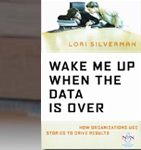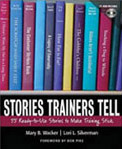One of my favorite weekend activities is to read the New York Times. What caught my eye about this interview by Adam Bryant with Dawn Zier, chief executive of Nutrisystem in his Corner Office column, wasn’t her background or management team approach, but her response to Adam’s last question, “How do you hire?” To which she responded, “I often will say, ‘Tell me about a situation where things changed around you and how you dealt with that and adapted.'”
Zier has formatted her inquiry to potential new hires as a story prompt—a statement that evokes narrative in the form of a story. She says that from this single inquiry she can learn the answers to these five items:
- Whether the person is self-made.
- Have they coasted in life.
- How they’ve persevered.
- Challenges they’ve had to overcome.
- What has shaped them over the years.
What I love about this example is that it demonstrates the true power of evoking stories from others: A single story prompt can replace the need to ask several questions. What she doesn’t say is that the telling of a story can reveal someone’s underlying motivations, personality temperament, emotional well-being, and a host of other qualities and factors that can’t be directly requested in an interview situation.
Questions primarily evoke information sound bites, descriptive statements, or opinions, many of which may be highly practiced (whether it’s a job interview or not). More often then not, you need to probe deeper to get the meaning you seek—a time consuming task. On the other hand, story prompts get people to tell you the story, the very way they experienced it since it’s the brain codifies and stores the situation as story narrative.
How do you construct a story prompt? They have two parts: the front of the statement (for example: Tell me about …) and the back of it (for example: … a situation where things changed around you and how you dealt with that and adapted.) Be careful: If you remove the word, about, all you’ve done is taken a question and made it into a statement. It won’t evoke a story unless the person was planning to tell you one to begin with.
In Business Storytelling for Dummies, we provide several front-end statements akin to “tell me about …” They include:
- Tell me a story about …
- Share with me a memory about …
- Paint the full picture for me about …
Stay away from these phrases to start a story prompt:
- Describe for me …
- Help me to understand …
- Explain to me …
The back end of the statement is as important to phrase correctly as the front end of it. Be specific. Get the person to recall one or two, or at the most, three stories when they hear it. “Tell me about an experience you liked in your last job” isn’t as effective as “Tell me about an experience in your last job that made you say, ‘Wow. I love what I do.'”
To switch it up a bit, you can reverse the front and the back of the story prompt. Using the last example, you could say, “In my experience, everyone has at least one moment in their last job when they say, ‘Wow, I love what I do.’ Tell me about that situation.”
Now it’s your turn. Where could you transform the questions you ask into story prompts to get better and richer responses?









Great ideas here, Lori. A couple of thoughts I coach my clients on as they elicit stories from candidates: 1) Be careful as an interviewer not to be captured or put-off by the storyteller’s ability or inability to tell his story (unless storytelling is one of the required core competencies). It’s important to remain focused on listening for the knowledge, skills, attitudes, behaviors, and even personality traits you desire to hire. 2) Stories are a great way to assess potential personality traits and cultural fit of a candidate. If someone goes into great detail and lots of facts, they may more likely focus on details in their job. Someone who tells a story more broadly, skipping details and giving you a big picture may reflect this in his role. What does the job require more of? Does the candidate’s story focus on the people involved or more on the facts or principles involved? What values or principles are you hearing? How did they make their way toward the goal? Were they striving headlong toward the finish line or utilizing more of a switchback approach? How does what you’re hearing mesh with what the employee needs to be and do to perform job and add value to the organization?
Excellent observations, Pam. Thank you so much for adding these pointers to the conversation!